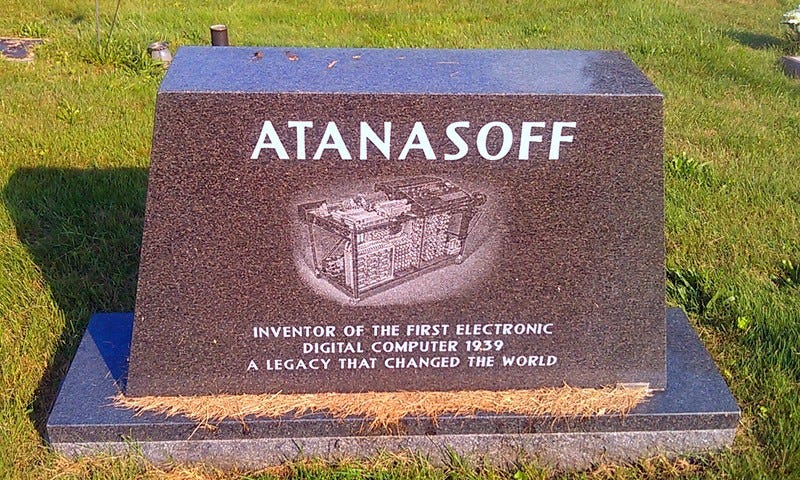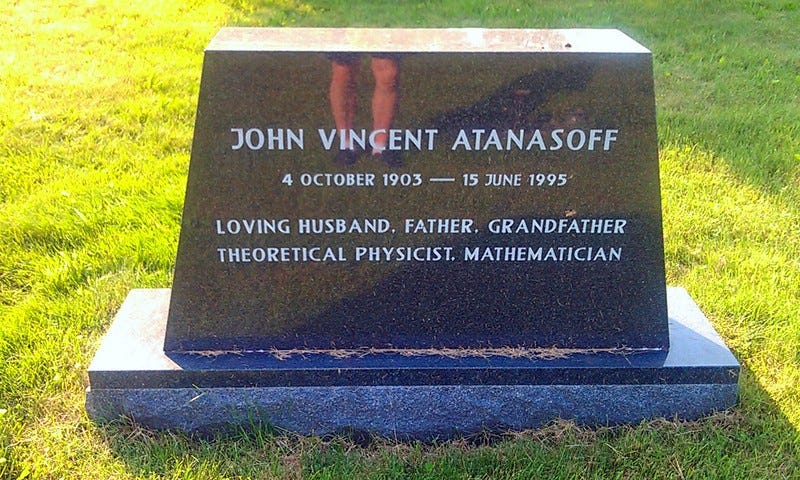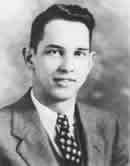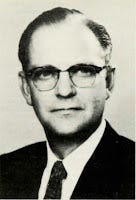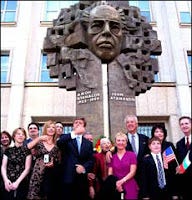John Atanasoff: American Civil Defense Legend and Visionary
The Greatest American Civil Defense Hero You've Never Heard of
Unfortunately, most American do not know their history or the incredible men and women who made their current freedoms (the freedom of speech, the freedom of worship, the freedom from want, and the freedom from fear among so many others) possible, which is one of the reasons those freedoms are being eroded.
One such remarkable man is John Vincent Atanasoff . He was the inventor of the computer and an American civil defense hero. I know. You probably never heard of him. That is not a mistake.
I spent my teenage years in Ambler, PA. Nearby was a rich kid whose last name was Mauchly who had huge personal music recording studio in his house. We heard his father invented the computer and he was wealthy due to that invention.
Later, when I attended the University of Pennsylvania on scholarship before it went communist and corrupt laundering millions to pay U.S. ex-Vice Presidents as a “professor” who did not teach students, we were inculcated with the great past accomplishments of the school.
One great Penn accomplishment we were taught was that Penn professors John W. Mauchly and J. Presper Eckert, Jr. invented the first computer, the Electronic Numerical Integrator and Computer (ENIAC) in the Moore School of Engineering at Penn and that this helped win WWII by running ballistic calculations.
But Mauchly and Eckert did not build the first computer. John Vincent Atanasoff did. To this day Penn omits Atanasoff’s invention in the Preceding Technologies page of its website about the ENIAC. Maybe they are embarrassed by the legal verdict (more below) that held that Atanasoff, not Mauchly and Eckert, invented the first computer.
There was depersoning of American legends and visionaries before recent years, and Atanasoff, sadly, was one of them. Like many civil defense hero’s, he lent his remarkable intellect and vision to quietly design defense systems that kept America safe from the Soviet Union and godless communism of the USSR and Red China from the 1940’s to the 1990’s.
Is there a device more important to everyday living than the computer? Atanasoff invented it under the name of the Atanasoff Berry Computer (ABC) in 1942. Then his invention was stolen from him. Eventually, he was buried at the Pine Grove Chapel in Mount Airy, MD in 1995…and largely forgotten. This was not by accident. You may see his remarkable gravestone in the back of the cemetery.
The computing principles discovered by Atanasoff's and built into his computer are the basis of millions of computers and the information revolution, without which modern society would not exist.
The big breakthrough was made by John Atanasoff who abandoned mechanics and designed electronic circuits for calculating by use of a binary system of numbers.
That you do not know of his invention is no accident given that Atanosoff’s invention plans were stolen from him in 1938 and used by the company Sperry Univac who, along with their prior corporate incarnations, used their corporate power to deperson him. He had to sue for 38 years to prove in court that he, and not Sperry Univac or John W. Mauchly and J. Presper Eckert, Jr., was the true inventor of the computer.
Atanasoff’s Invention of the Computer Story
In 1937, a professor of mathematics and physics went for a long drive to Illinois during which he conceived several ideas that still change the world. These ideas led Professor John Vincent Atanasoff (together with his PhD assistant Clifford Edward Berry) to invent and build the Atanasoff Berry Computer (ABC), the first DIGITAL electronic computer.
They built it in the basement of the physics building at Iowa State College during 1939–42. Atanasoff was driven by the need to solve physics problems using long numeric equations.
Among the breakthroughs that Atanasoff made were the following ideas that are the first principals of every computer built since, all of which he jotted down on a napkin in a tavern.
Electricity and electronics, not mechanical methods
Binary numbers internally
Separate memory made with capacitors, refreshed to maintain 0 or I state
Direct 0-1 logic operations, not enumeration
From these ideas, he was able to successfully build the ABC. The ENIAC successor, and all subsequent computers, are based on these ideas.
For memory, the ABC used electrostatic store-drums made up of 1600 capacitors each. These capacitors are used to store a small charge representing the 1, or on, state. The off, or 0, state was represented by no charge. Therefore, binary numbers could be stored onto the drums.
This is the first use of the idea now known as DRAM, a modern day technology used in today’s computers. The ABC was a specific-use computer, designed to solve systems of linear algebraic equations, and was capable of solving systems with up to 29 unknowns.
What is remarkable about John Atanasoff’s computer is that he created it on his own, with no real financial backing from companies or the government like future projects such as the ENIAC, EDVAC or UNIVAC.
In 1942, John Atanasoff was called on duty and he started a defense-related position in the Naval Ordnance Laboratory in White Oak, MD, as a theoretical physicists to work on various projects related to mines disarming, underwater bombs, and rockets. He participated in the atomic bomb tests at Bikini Atoll n 1946.
John Vincent Atanasoff's papers are archived here.
Between 1942 and 1966, most of his scientist work was related to the dynamics of sea vessels.
He holds patents to over 30 different devices (for a device for capturing and recording seismic sound waves, a post office sorting system, automated systems for package preparation and others).
In 1973, after a Federal patent judge voided a patent owned by Sperry Rand Corp. on ENIAC, the Atanasoff-Berry Computer was credited as the first electronic digital computer. This decision put the invention of the electronic digital computer in the public domain and granted legal recognition to John Atanasoff as the inventor of the first electronic digital computer.
The amazing story of Anastoff’s trial to reclaim his stolen honor and invention can be found here.
The trial that started on 1 June 1971 consumed over 135 days or parts of days. A total of seventy-seven witnesses had given oral testimony, and an additional eighty witnesses were presented through deposition transcripts. The first indication of Judge Larson's decision came in April 1973, after he provided lawyers for Honeywell and Sperry Rand copies of a proposed decision and asked for their comments on that decision. That tentative decision was leaked to the Minneapolis Tribune and Star and staff writer Bob Lundegaard wrote an exclusive story for the 12 April 1973 newspaper stating that Judge Larson had ruled that the basic ENIAC patents held by Sperry Rand were invalid.
When Judge Larson distributed the formal opinion on 19 October 1973, it was everything that Atanasoff had hoped it would be. It was clear and unequivocal finding that Mauchly's basic ENIAC ideas were "derived from Atanasoff, and the invention claimed in ENIAC was derived from Atanasoff." In extensive findings, Judge Larson declared: "Eckert and Mauchly did not themselves first invent the automatic electronic digital computer, but instead derived that subject matter from one Dr. John Vincent Atanasoff."
The timing of the publication of the decision on 19 October 1973 brought it into competition with the explosive "Saturday Night Massacre" in the continuing Watergate scandal of the Richard Nixon presidency. That particular story would have reduced the display on any other story that night. However, that does not adequately explain the ignoring of a story that was of great significance to the world of science--mathematics, physics, and the rest of the world influenced by and vitally interested in computer science.
Following World War II, John Atanasoff remained with the government and developed specialized seismographs and microbarographs for long-range explosive detection. In 1952, he founded and led the Ordnance Engineering Corporation, selling the company to Aerojet General Corporation in 1956 and becoming Aerojet's Atlantic Division president.
In 1960, he and his wife Alice moved to their farm in New Market, MD. In 1961, he started another company, Cybernetics in Frederick that he operated for 20 years. In 1970, John Atanasoff was invited to Bulgaria (his father John emigrated to the U.S. in 1889 at 13 from Bulgaria) by the Bulgarian Academy of Sciences, and the Bulgarian Government conferred to him the Cyrille and Methodius Order of Merit First Class. President George H.W. Bush awarded him the National Medal of Science and Technology in 1990.
John Atanasoff’s father, Ivan, was a Bulgarian immigrant. On October 4th, 2003 on the 100th birthday of John Atanasoff, Bulgaria named him the “electronic Prometheus” who gave birth to digital computing, and dedicated a monument to him in Sophia, noting that his creation incorporated several major innovations in computing including the use of binary arithmetic, regenerative memory, parallel processing and separation of memory and computing functions.
John Vincent Atanasoff was the inventor of the digital computer, father of the modern computer, WWII war research victory contributor, company founder, husband, father, immigrant’s son…the man who quietly revolutionized the world…and then for years had to defend the theft of his invention from very powerful companies in multiple lawsuits.
His life and work contributed mightily to the American Dream and to the success of American civil defense from 1942 to 1994 and to today. An immigrant’s son who knew genius required grit to succeed. We all, especially everyone who has used a computer, owe him a huge debt of gratitude.
The next time you send out an e-mail or play a video game, you have a former New Market resident to thank.
John Vincent Atanasoff lived in a home on the east side of New Market for over 30 years, watching the countryside change just like everyone else in Frederick County.
Unlike everyone else, however, Atanasoff happened to have invented one of the key technological advances of the modern age. His calculating machine, created over 60 years ago at Iowa State College (now University), was ruled in 1972 to be the first in a long line of evolution that most recently has churned out Pentium processors and G4s.
For that reason, Atanasoff is credited with being the computer's inventor, and today, seven years after his death, is called its forgotten father. So why, then, is Atanasoff not a household name?
The reason is that Atanasoff only got credit for his original idea after decades of other people claiming it as their own. According to some of the many biographies of Atanasoff, the highly-contested inspiration for his rudimentary computer came to Atanasoff in 1937, when he was a professor at Iowa State College.
One night as he struggled with the problem of designing a device that could quickly solve complex math problems, he went for a long drive and ended up a tavern in Illinois. Over a shot of bourbon, he realized some of the inherent principles of his invention: he could use electronic, rather than mechanical, components for the device, and use the base-2, binary system.
For three years, Atanasoff worked on this new computer with a graduate student, Clifford Berry. By December of 1939, they had built a promising prototype of the Atanasoff Berry Computer (ABC), which intrigued many people, including one scientist named Dr. John Mauchly.
Atanasoff readily talked with Dr. Mauchly about the prototype, and even had him as a houseguest at his home in Iowa. In the following years as World War II erupted, Atanasoff was sent to Washington to do research for the Naval Ordinance Laboratory.
He tried to get a patent for his device, however because of high turnover, the documents were "shoved back in a drawer and forgotten," said William O'Toole, computer science professor at Mount St. Mary's College and long-time friend of Atanasoff. Meanwhile, Mauchly and Dr. Presper Eckert Jr. developed the now-famous machine called ENIAC and sold it to the U.S. Army.
As time went on, Mauchly and Eckert gained the patents and the credit for the first electronic digital computer. From that technology evolved many of the modern devices we use today, from cell phones to iMacs, while the ABC was dismantled to make more space in the Iowa State lab. Atanasoff got other jobs, and in 1963 Berry was found dead in Coney Island, a case O'Toole said the court ruled was a suicide.
It was three decades after the idea's fruition when the matter mushroomed into a three-year-long court case. One computer industry giant, Honeywell Corp., sued another corporation, Sperry Rand Corp., trying to invalidate the Mauchly-Eckert patents it owned.
During those deliberations, Atanasoff gave testimony that brought all of Mauchly and Eckert's ideas into question. After a massive investigation, the judge found that the ENIAC computer relied on innovations made in Atanasoff's prototype, in other words, that it was Atanasoff who invented the first computer.
However, this was not news to Atanasoff's wife, Alice. During all the years in which his invention went unrecognized, she said they thought it was "just the way life was."
This disappointment did not stop Atanasoff from further accomplishments and inventions. Alice said that he held 32 patents, some of which came from his days working for the government during WWII.
Of those, some are still classified. He worked successfully at a number of jobs and operated a engineering business called Cybernetics, Inc. in Frederick for almost 20 years.
Once the announcement was made that the computer was his idea, Alice Atanasoff said that they had hoped for more fanfare. Only with time was he was decorated with awards and accolades, including the National Medal of Technology, presented at a ceremony at the White House. Iowa State University named a hall after him, and in 1997 rebuilt his ABC computer at a cost of $300,000.
"He really opened up the computer industry, competition came in at that point," O'Toole said. O'Toole listed five specific developments that Atanasoff was responsible for, four of which were stolen by Mauchly and Eckert.
The only one of those five that they did not use in ENIAC was using a binary system for calculations, which O'Toole said is now the industry standard.
In spite of those accomplishments, the Atanasoffs were never to see any of the financial benefits of such a wide-sweeping invention, and even today many textbooks still list Mauchly and Eckert as the original inventors. According to Alice Atanasoff, that is because once people had their beliefs established, they were not going to change their minds.
Still, what people think does not change her husband's impact on technology, and on the people around him. When the lawyers searched his background as part of the suit, she said that they had talked to many of his old acquaintances.
"Most thought he was the most brilliant man they ever knew--but fun," she said. O'Toole listed a bevy of great qualities Atanasoff had, including his humor and warm-hearted nature. "I am happy and proud to say we were good friends," O'Toole said.
Alice Atanasoff moved with her husband after his retirement to their farm in New Market in 1960. They chose the area because they both liked the peace of a farm, and the people and atmosphere of Frederick County. Alice Atansoff still lives in their hilltop home, whose modern architecture was partially designed by her husband.
Although the Atanasoffs were never active in the town government, she said that they had good friends in the area. Alice said that it was interesting for them to watch the changes in the area, as the landscape went from no houses on the horizon to the current development.
After Atanasoff died from a stroke in 1995, he was buried in Pine Grove Cemetery in Mount Airy, where a monument to him still stands.
That cemetery should be the site of some festivities next year in honor of what would have been Atanasoff's 100th birthday in October of 2003, according to Alice Atanasoff. At the same time, a huge celebration is to be held in Bulgaria. Since Atansoff's grandfather was a Bulgarian patriot, that country has a special tie to his accomplishments.
As a result, the Bulgarian government will be dedicating a monument, a commemorative coin, and a postage stamp as celebrations are held across the country at the same time as local tribute is paid to the former New Market resident.
John Vincent Atanasoff’s Survival Bunker was Right out of the Jetson’s
His 1961 bunker house is next to the I-70 State Police Truck Weighing Station on U.S. Route 70 right outside of Mount Airy, MD. He built several stories of this house right out of the Jetson’s cartoon underground to survive a potential nuclear war. Although I have never been inside, here is my take of it and his legacy from the highway.
NOTE: I apologize for the sideways view as I narrate. I forgot four years ago when I made this video that if I hold my Samsung cell phone upright rather than sideways it films sideways.
Civil Defense Bunker Bonus Tip
Atanasoff knew the worth of a bunker to keep his family safe. He builat a beautiful space-age house in Mount Airy, MD that was basically one large bunker.
Underground Shelters USA by Utah Shelter Systems has been building affordable, family friendly, bunkers since 1987. They design complete disaster shelters.
Millionaires and billionaires are building themselves shelters to keep their families safe during disasters. Maybe you should, too.
Underground Shelters USA spent years designing a shelter to protect you from both natural and manmade disasters. Our engineers have built these to be full spectrum all hazard shelters. They are hardened NBC shelters, providing defense against all nuclear weapons effects including blast, radiation, EMP, and chemical and biological warfare agents. They are safe rooms, insuring protection of individuals and supplies from unlawful entry; and they are storm shelters, designed to withstand hurricanes, tornados, wild fire, winter storms and loss of power from solar storms.
Full disclosure: Underground Shelters USA is co-owned by Sharan Packer, who is also the volunteer Secretary of The American Civil Defense Association (TACDA.ORG) where I am the volunteer Vice President. I have known her for over 15 years and can vouch for her underground shelter and civil defense professional competence and honesty.
Sources:
http://jva.cs.iastate.edu/jvabio.php
http://paul.luon.net/essays/HoC-Atanasoff.pdfhttps://www.fredericknewspost.com/news/science_and_technology/years-after-death-computer-inventor-still-celebrated/article_3afbb911-fee1-5722-b51a-3159bd92a0b1.html
https://www.thocp.net/biographies/atanasoff_john.html






